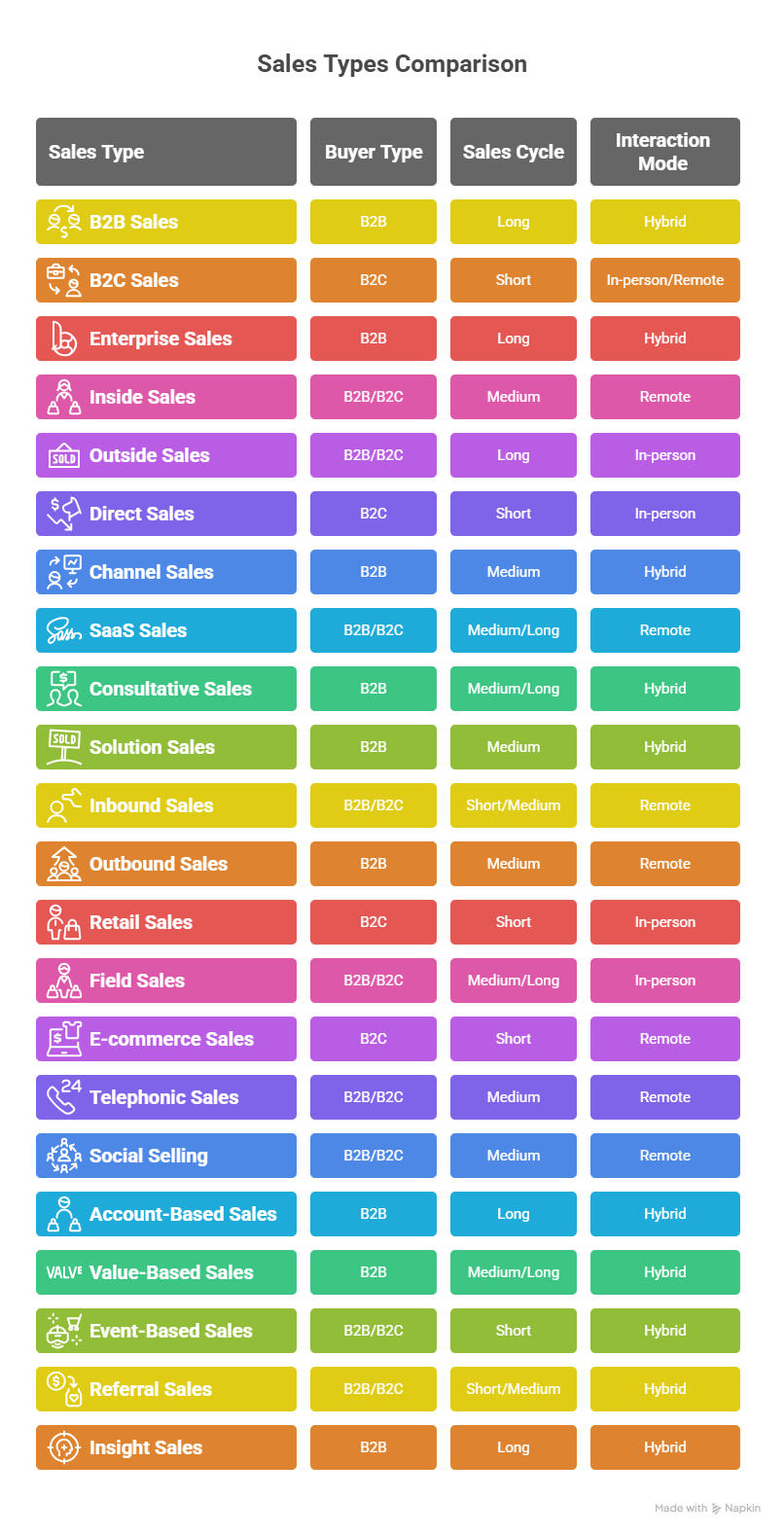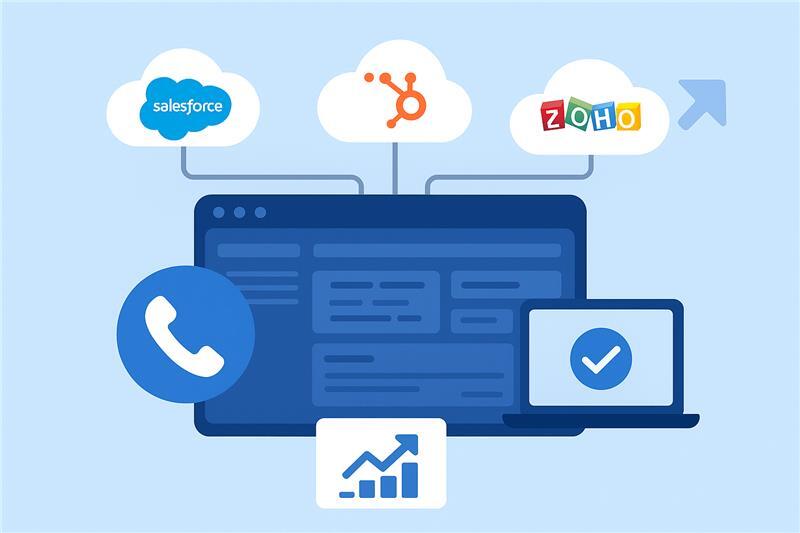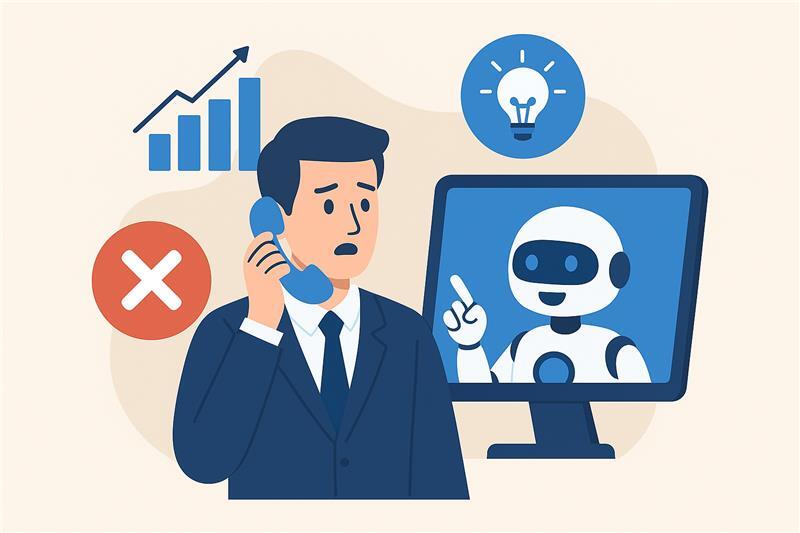
22 Types of Sales Every Business Should Know (And Use)
Let’s get this straight - sales is not just a one-size-fits-all strategy. It’s not just about discounts and urgency banners. Instead, sales is all about how your product meets the person who needs it and convinces them that they cannot live without it.
Sales don’t work on a single-play approach. What works for selling life insurance doesn’t work for selling cosmetic products. And SaaS? That’s a whole different world.
In this blog, you will find a detailed account of 22 different types of sales, allowing you to select the right playbook. Whether you’re running a B2B SaaS startup or a D2C skincare brand, this list is ideal for you. Here, you’ll find the different sales types, where they work best, what the buyer journey looks for in each, and why they matter.

Glance table: Comparative overview of 22 sales types

1. B2B sales
When you’re involved in a B2B sales, it is an amalgamation of corporate gatekeepers. Here, you as a company deal with another company that is of a high value. Here, you mostly don’t deal with a decision maker, but rather with multiple stakeholders over several months.
Key features:
- Your B2B business is all about multiple stakeholders. Since each have their priorities, your sales pitch different accordingly.
- Since buyers want proof, your pitch should demonstrate what the business gains in terms of ROI.
- B2B deals do not close in a day. It needs weeks of nurturing, pilot programs, demos, legal reviews and internal approvals.
Pros and cons:
2. B2C sales
B2C, or business-to-consumer sales, are where your brand directly sells to consumers. Whether you are selling cupcakes, headphones, or skincare serums, it’s all about catching the attention of consumers quickly and closing the sale even quicker. This kind of sales involves a complex combination of storytelling, UX, design, and pricing. Since your buyer is a human with emotions, you need to nail your message in milliseconds.
Key features:
- Since impulse rules this sphere, incorporate emotional aspects into marketing products or services to generate aesthetics, urgency, and FOMO.
- Your brand voice is part of the product. Cheeky packaging, fun ad copies and relatable emails all add up to the vibe.
- Here, speed matters more than depth. Everything about marketing the product should be about creating micro-moments.
Pros and cons:
3. Enterprise sales
In enterprise sales, you’re not just trying to win over one decision-maker, but you’re navigating an entire matrix of influencers, legal guardians, approvers and budget-holders. Here, you pitch to powerhouses and not just any small team. And, with power comes a lot of paperwork. So, expect months of demos, discovery, proof of concept, contract negotiations, compliance checks and internal audits.
Key features:
- You’ll be selling to multiple stakeholders. It means you need tailored messages for each one of them.
- Enterprise clients want results and not flashy demos. They want to know whether their investment is worthy.
- Enterprise sales require custom Service Level Agreements (SLAs), bespoke solutions, and alignment with the client’s internal workflows.
Pros and cons:
4. Inside sales
Inside sales is the modern hustle where you close bigger deals remotely. You don’t need to run to the airport lounges to meet your client. You could be sitting in India while closing clients in Boston. For this, all communications are conducted virtually. All you need is a killer email thread, Zoom calls, and CRM dashboards. It is fast, flexible and ridiculously efficient.
Key features:
- All sales are conducted over the phone, via video calls, email, and chat. This means a higher reach with a shorter sales cycle.
- Inside sales lives inside tools like CRMs, sales intelligence platforms like Salesken.ai, and complete automation processes.
- You can run custom outreach at scale, ensuring that touchpoints do not feel repetitive or boring.
Pros and cons:
5. Outside sales
Think of sales that happen in boardrooms, cafes, trade shows and anywhere outside the office. This is outside sales. It occurs face-to-face, in an old-school format, and is an entirely human-to-human selling process. This kind of sale prioritises networking and building relationships in person. If your deal size is fat and the product is complex, this model works best.
Key features:
- Outside sales thrive when the stakes are high and the entire purchase is a big decision.
- You earn trust in an old-fashioned way - by showing up, listening and adapting in real-time.
- Sales reps customise demos and conversations depending on the prospects, what they care about, and how sceptical they appear.
Pros and cons:
6. Direct sales
If you want to make a sale without paying for ads, fighting algorithms or SEO, direct sales is all that you need. It’s old-school, but it has a powerful sales model that allows you to pitch directly to the buyer. So, it’s just you, your product, and the customer talking face-to-face to negotiate the deal. It’s a kind of grassroot selling where you build personal connections and sell through trust.
Key features:
- Here you have actual conversations through one-on-one engagement with instant customer feedback.
- No intermediary is involved here. You are the distributor, salesperson and relationship manager - all rolled into one.
- Here, customers remember you because of the kind of value you provide and the relationship you build.
Pros and cons:
7. Channel sales
When you distribute your products through third parties, such as affiliates, resellers, or distributors, it’s channel sales. Consider them as your sales sidekicks - they handle outreach, demos and support in return for a commission or profit margin. To make channel sales effective, both you and the third party must have aligned goals, clear incentives, and proper onboarding procedures. If your business needs multi-regional popularisation, channel sales can help you grow faster.
Key features:
- Your partners handle the customer interactions while you support them from the background.
- You can expand into new markets, regions and verticals without having to hire massive sales teams.
- This sales model thrives on strong incentives and co-branded marketing campaigns.
Pros and cons:
8. SaaS sales
SaaS sales is all about forming a combination of building relationships, retention therapy and checking the performance analytics. When you’re selling Software-As-A-Service, you’re not just selling the product. You’re pitching a long-term relationship with the buyers. Here, you blend onboarding, marketing, support, loyalty building, and upsell nudges, all while tracking clicks. It’s like developing a long-term situationships based on metrics.
Key features:
- SaaS sales come with a recurring revenue model, where you receive monthly payouts while handling pricing and pitching.
- The sale here depends on customer success, where you help the buyers use the product for their business growth.
- SaaS sales tracks everything - from CAC to churn rate. You know what worked, what flopped and who ghosted at the onboarding process.
Pros and cons:
9. Consultive sales
Consultative sales is like a five-course meal, built with conversation, context and a customised solution. You are not pushing a product down someone’s throat. Instead, you draw insights from the product and show it to the customers until they realise its worth. Such a sales approach flips the script, as it’s not about talking more, but about listening better. This is an excellent sales option for niche solutions, high-stakes deals, and individuals seeking a partner.
Key features:
- Before pitching the product, you should ask about buyer demand to understand their actual pain points, not just surface-level needs.
- You emphasise the buyer’s problems, show them the risks of their inaction to generate tangible outcomes.
- Send customised proposals to tie directly to what the client requires, as well as to problems they were unawar ofe.
Pros and cons:
10. Solution sales
Let’s say your customer walks in frustrated. They already know something is broken. But they have not yet found the tool or the product that can fix it. This is where you need solution sales, where you connect the dots between the customer’s pain and your solution. Here, storytelling meets strategy to build their trust.
Key features:
- In solution selling, you highlight the problem and the entire sales pitch is built around how the problem can be solved with your product.
- Every pitch is customised - you tweak the message, the use case and even the interface, if needed.
- It involves ROI-based storytelling, where you reduce costs, save time, and generate more revenue.
Pros and cons:
11. Inbound sales
Dreamt of customers walking up to you to buy your product or service? This is inbound sales. Perhaps through a social media post, a reel, or a blog, your customers discover you, prefer your work, and connect with you. In short, you attract people with helpful resources, valuable content, and genuine answers that they are already searching for on Google. It’s the pull strategy that works best for SaaS, agencies, and D2Cs.
Key features:
- Inbound sales are all about intent-based conversations where your sales team starts with warmer messages and more qualified prospects.
- It weaves learning into the sales process to build trust and generate more conversions.
- Once your content engine is running, leads can pour in 24/7.
Pros and cons:
12. Outbound sales
Outbound sales occur when you reach out to customers after identifying their pain points. It’s the first bold move where you show customers how your product can be a saviour to their problems. Unlike inbound, outbound asks you to find the right people, grab their attention and give them a reason to choose your products over others.
Key features:
- It is a proactive lead generation process where you flip the sales funnel and actively target ideal buyers.
- Here, you need a multi-channel outreach process to target your customers across all social channels.
- Outbound sales are divided into sales development representatives and account executives, who focus on closing deals.
Pros and cons:
13. Retail sales
This is the original sales playground, the OG sales format, where you don’t need Wi-Fi, just a product, a human, and a price tag. It’s all about the in-store experience. In retail sales, people walk into a store with zero intent and walk out with bags full of products they did not even plan to buy. This happens because they felt those products could be helpful. Retail sales are based on creating moments - a demo that sparks curiosity, a well-timed behaviour, or a detailed layout that guides decisions.
Key features:
- Retail sales thrive on face-to-face engagement, where your sales representatives can instantly respond to cues.
- Buyers get to see, touch and try the products in real life. This kills hesitation and builds confidence.
- The decision-making cycles made by buyers are extremely fast, as they don’t involve any emails, threads, or follow-ups.
Pros and cons:
14. Field sales
When deals cannot be closed over Zoom meetings, field sales teams step in. Here, sales reps hit the road, knock on buyers’ doors, and sit in offices, actually showing up where the client is. Field sales is personal and suitable for industries where trust is non-negotiable. Though this is an old-school model, field sales still reign supreme when done right.
Key features:
- Sales reps organise scheduled and face-to-face meetings where they set up appointments and meet leads in their comfort zone.
- To create a high-trust selling environment, field sales representatives read non-verbal cues and adjust their pitches based on body language, mood, and reaction.
- This is common in regulation-heavy industries, such as pharma, FMCG, finance, and government, where building relationships is particularly important.
Pros and cons:
15. e-Commerce sales
E-commerce sales is a more convenient version of retail sales, where you skip the store, avoid the long queue, and help buyers purchase products even at 11 pm from their couch. In this sales model, the e-commerce website is the salesperson. There must be a perfect alignment between the product descriptions, layout, and checkout flow. Since there are no humans to clarify, your messaging, design and logic must be bulletproof.
Key features:
- It promotes self-service where buyers browse, compare and buy products without anyone’s suggestion or guidance.
- The e-commerce platform tracks the buyer's behaviour in real-time and recommends products accordingly.
- Here, automation serves as the backbone, retargeting emails, providing chatbot support, and confirming order workflows.
Pros and cons:
16. Telephonic sales
If you consider emails slow and in-person sales pricey, telephonic sales can be your saviour, if done right. This is the original method of remote selling, predating the advent of Zoom and Google Meet. Back then, sales reps were already leaving voicemails, dialling numbers, and capturing prospects. It ranges from cold calls and warm lead follow-ups to retention check-ins and marketing campaigns.
Key features:
- Here, real-time customer engagement occurs via phone calls, and sales representatives receive instant feedback.
- This is a low-cost outreach method that requires sales reps to have a contact list, a phone line, and a decent script.
- A good sales rep can make a lead feel important and the only person that matters.
Pros and cons:
17. Social selling
Not every deal starts with a demo call. Some can start with a DM or a social media post comment. That is social selling - building an authentic relationship over a platform where your audience is present. Unlike traditional selling, social selling asks you to show up consistently, offer value and make your presence felt. In short, it’s low on pressure and high on trust.
Key features:
- Since social selling depends on a platform-based outreach process, it’s all about being relevant where it matters.
- To establish your position as an expert in the market, create insightful,,valuable and relatable content.
- Social selling thrives on building authentic and human connections, right from replying to comments to sliding into prospects' DMs.
Pros and cons:
18. Account-based sales (ABS)
Account-based sales is all about laser precision. Instead of chasing a hundred leads every day, account-based sales ask you to focus only on the top ten premium leads. Here, you choose those dream companies you feel can change your ROI. For this, you send personalised emails and custom demos to demonstrate your value in the industry.
Key features:
- Account-based selling focuses on hyper-personalised campaigns, where every message, meeting, and asset is crafted specifically for that one prospect.
- This method of selling is effective only when marketing and sales collaborate to create tailored content and campaigns.
- Here, you engage with a buying committee with tailored narratives that make sense to them.
Pros and cons:
19. Value-based sales
While some people sell features, others sell benefits. However, value-based sales focus on delivering real and measurable outcomes. Instead of talking about what your solution does, here, you frame every conversation around what the buyer gets. Here, your sales reps need a deep understanding of the buyers’ goals, serious listening skills, and storytelling techniques. It’s all about closing deals that feel like a no-brainer.
Key features:
- Here, you progress with the lead by showing transformations that resonate with buyers on a deeper level.
- To show value, you need to research and find out what your buyers value, their goals, pain points, and KPIs.
- It follows an ROI-based storytelling approach to build trust with solid proof.
Pros and cons:
20. Event-based sales
Event-based sales is much more than just sending brochures and hoping for the best. Rather, with event-based sales, you create a high-intent and high energy environment where your team connects with prospects in real time. The primary goal of event-based sales here is to seize the momentum. Here, you connect with buyers virtually and make your product shine through positive conversations.
Key features:
- Event-based sales let’s you pitch in real time where the audience is completely alert and provides immediate reaction.
- The event-based sales setup includes QR code, CRM-ready forms, and a badge scanner.
Pros and cons:
21. Referral sales
Referral sales comes with a strategy where you nudge your customers and built trust. Here, people are more likely to purchase something that their friend has recommended. Here, you’re not closing deals, you’re chasing credibility. The secret of conducting referral sales successfully is to ensure customers are happy so that they can be your brand advocates later.
Key features:
- Referral sales relies on your existing customers to generate more leads.
- Referrals come with built-in credibility where your customers focus more on how you listen to your prospects rather than pitch decks.
- Referrals programs with perks can boost participation and drive more leads.
Pros and cons:
22. Insight sales
Insight sales is similar to consultative selling where you’re not just selling a product, but shifting the buyers’ mindset. Here, the buyer already knows the problem. Your job is to make more innovation happen much faster than people think. If your sales team is into competitor activity, market data and user behavior trends, insight sales is the wakeup call your buyer needs.
Key features:
- You lead the pitch with industry reports, case studies and trend graphs to reveal a market risk or shift.
- Your sales reps challenge the customers’ current assumptions and shows how they think about their business.
- Here, your sales team acts like a domain expert to build trust and credibility.
Pros and cons:
Top 5 AI platforms to manage modern sales
Honestly, your modern sales teams today do not just need a CRM. They need an automated co-pilot, a mind-reader, a metrics nerd, and a coach. Basically, they need AI that does all the work to help you close smarter deals. Here is a brief list of top 5 AI sales platforms that quietly speed up the sales process now:
1. Salesken.ai
Salesken.ai is that perfect AI coach you’ve always desired to have. It’s AI sales assistant sits right on your sales calls to give you the right cues when you fumble. It listens, analyses and nudges sales reps during lead calls with real-time prompts, especially when the reps go blank. Besides, it has a quality assurance metric that analyses leads and fills your sales pipeline only with those that are interested. Further, the revenue intelligence feature of Salesken gives you an idea about the estimated ROI even before closing a deal.
Why it matters?
- It shows what your best reps are doing right and where they need improvement.
- It gives live cues during calls to help your reps with the perfect pitch.
- It spots the moment a buyer mentally checks out and helps your sales team with a solution to fix this.
2. Gong.io
Gong uses machine learning and artificial intelligence to listen, analyse and comprehend sales calls. It decodes what is working and highlights what is not. Not only does Gong capture data, it also tells what the data means. Right from talk ratios to buyer intent, Gong digs deep into every sales conversations to improve.
Why it matters?
- Transcribes and breaks down every sales call.
- Shows the performance of each sales reps and their strengths and weaknesses.
- Flags risks in the deals before they miss with your sales pipeline.
3. Clari
Clari is all about providing clarity of your sales calls. It takes all the messy sales data from your CRM, your spreadsheet, your sales reps’ notes and transforms it into revenue intelligence. So, you get a detailed picture of what’s working, what’s stalling and who’s likely to ghost your sales pipeline.
Why it matters?
- It syncs all scattered data, connects them to your CRM and reveals revenue insights.
- It highloights where the deals get stuck and why.
- It gives leadership the actual visibility of your sales pipeline.
4. Choris.ai
Choris no less than the sixth sense that can add a new meaning to your sales conversations. Along with hearing what the buyer says, Choris also hears what they mean. Just like an emotional intelligence tool, it picks up on the disinterest, hesitation, and excitement, and translates them into insights that your sales reps can use.
Why it matters?
- It identifies customer intent and tone in real life.
- It highlights follow-up urgency before you forget.
- Based on subtle language signals, it surfaces deal risks.
5. Outreach.io
Outreach can be your sales team most favourite intern, working 24/7, never missing a follow-up, and writing killer emails on demand. It is the ultimate way to simplify prospect outreach. Instead of your sales reps, Outreach does the heavy lifting as it’s primarily built for hustling without burnout.
Why it matters?
- It streamlines outreach sequences across all platforms so that nothing slips away.
- It tracks engagement metrics like clicks, opens and replies to help your sales team chase the right prospects.
- It personalizes snippets and templates to meet customer expectations and make things more tailored.
Conclusion
By now, you’ve met all the 22 types of sales and have seen how the best AI sales tools are combining automation and tech smartly. Now, in the modern scenario, sales is not just about charm and persistence. Instead, it’s about choosing the right approach for the right buyer at the right moment.
It’s impossible to try out all 22 different types of sales. So, now, you would pick out your target audience first, followed by choosing the right sales model and equipping your sales team with the right tools. This is where Salesken comes in. From giving prompt cues to analysing what went wrong in a sales call, Salesken quanitfies everything to close high-quality deals.
FAQs
1. How do I know which sales type is right for my business?
Start with your product and audience. Ask these questions:
- Are you selling to businesses or consumers?
- Is your price point low or high? Do buyers need education or can they click and checkout?
Use the answers to narrow your choices. Most brands use a mix, so test and tweak until you find what clicks.
2. Can I combine multiple sales models?
Absolutely. Enterprise companies often use inbound for top-of-funnel, outbound for high-value leads, and account-based sales for key clients. Mixing models lets you scale, personalise, and adapt without burning your team out.
3. Is AI really necessary in modern sales?
Yes, because your competition is already using it. AI platforms like Salesken.ai give your team live feedback during calls, highlight deal risks, and track what messaging works. You get sharper insights, faster training, and better results—without burning out your reps.
4. Which sales type is best for SaaS companies?
SaaS works well with inside sales, inbound marketing, and account-based approaches—especially if you offer a free trial or demo. Customer success and renewals are just as critical, so think beyond the first deal.
5. What is the role of CRMs in all of this?
CRMs track leads, conversations, pipeline stages, and team performance. Whether you are running cold outreach or inbound flows, a good CRM keeps you organised and on target.

.png)

